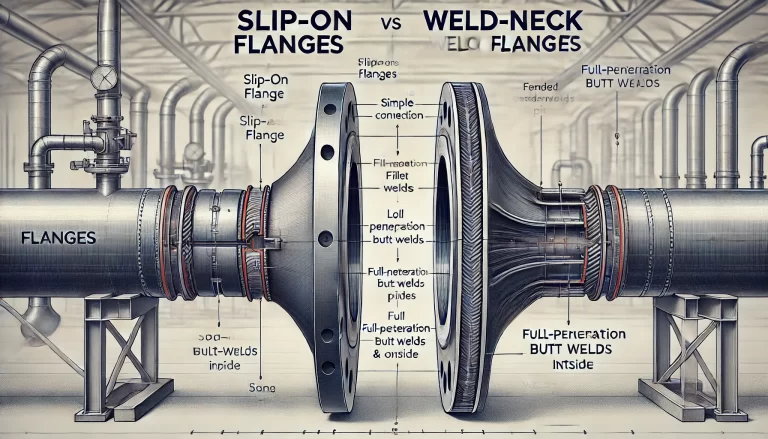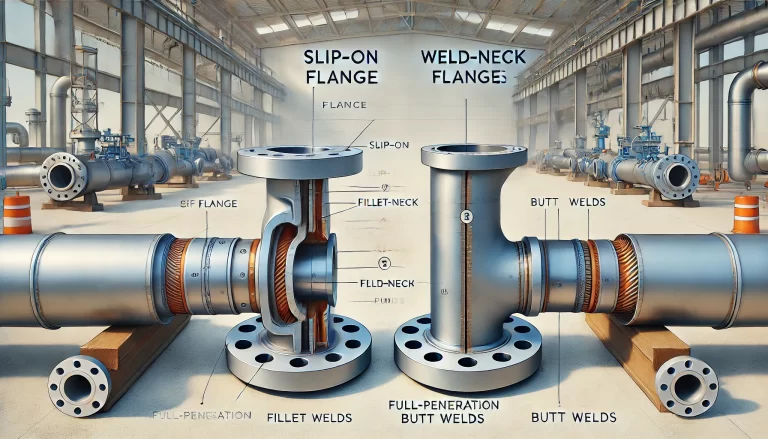Flanges are essential components used to connect pipes, valves, pumps, and other equipment in a piping system. Two common types are slip-on flanges (commonly referred to as SO flanges) and weld-neck flanges (WN flanges). They differ significantly in terms of structure, welding methods, mechanical properties, and applications. This article provides a detailed analysis of these differences.
1. Structural Characteristics
Slip-On Flange
A slip-on flange is designed with a bore diameter slightly larger than the pipe’s outer diameter. During installation, the pipe is inserted into the flange before welding. The face of the flange remains flush with the pipe’s surface, simplifying the alignment process. Only the outer edge of the pipe is welded to the flange, making it a simpler and faster connection.
Weld-Neck Flange
The weld-neck flange has a long tapered hub, known as the neck, which transitions smoothly into the pipe. This neck is typically beveled to match the end of the pipe for a full-penetration butt weld. This structural design enhances the flange’s strength and distributes mechanical stress evenly along the pipe connection.

2. Welding Process
Slip-On Flange
- Welding is performed on the outer side of the flange after the pipe is slipped in.
- It uses fillet welds, which are relatively easy and quick to execute.
- Only single-side welding is required, leading to lower labor costs and minimal complexity.
Weld-Neck Flange
- Requires butt welds on both the inside and outside of the pipe and flange connection.
- Welding demands a higher level of skill and precision because it ensures a full-strength connection.
- The process is more time-consuming, but the result is a stronger and more durable joint.
3. Strength and Stress Resistance
Slip-On Flange
Slip-on flanges are less robust than weld-neck flanges. The absence of a tapered hub means that slip-on flanges have weaker resistance to high-pressure or high-temperature conditions. Additionally, they do not distribute stress as evenly, making them more prone to fatigue in dynamic environments.
Weld-Neck Flange
The tapered neck and butt-weld design significantly improve the strength of the weld-neck flange. It can withstand extreme pressure, temperature fluctuations, and dynamic forces. The flange’s structure helps in reducing stress concentration, making it ideal for critical applications in industries like oil, gas, and power generation.
4. Sealing Performance
Slip-On Flange
Due to its less robust design and simpler weld connection, slip-on flanges generally have weaker sealing capabilities. Over time, they are more susceptible to leakage, especially in systems with frequent pressure changes or vibrations.
Weld-Neck Flange
Weld-neck flanges offer superior sealing performance because of their full-penetration welding and better alignment. They are less likely to develop leaks, even under high-pressure or high-temperature conditions, ensuring the reliability of the piping system.

5. Installation and Cost
Slip-On Flange
- Easier to install and align because the pipe can be inserted into the flange.
- The welding process is straightforward, resulting in reduced installation time.
- It is cost-effective due to its simple structure and reduced labor requirements.
- Commonly used in low-pressure applications where installation speed and budget are key considerations.
Weld-Neck Flange
- Installation is more complex and time-consuming due to the need for precise alignment and double-side welding.
- The tapered neck and high-strength welds make manufacturing and labor costs higher.
- It is used in high-pressure, high-temperature, and critical systems where reliability outweighs cost concerns.

6. Applications
Slip-On Flange
Slip-on flanges are suited for:
- Low to medium-pressure systems (typically ≤ 2.5 MPa or 362.5 psi).
- Situations where frequent maintenance or replacement is required, as they are easier to handle.
- Non-critical systems in water treatment, HVAC, and general industrial pipelines.
Weld-Neck Flange
Weld-neck flanges are essential for:
- High-pressure, high-temperature systems (commonly ≥ 2.5 MPa or 362.5 psi).
- Piping systems handling corrosive or hazardous fluids.
- Critical industrial sectors like petrochemical plants, power plants, and offshore oil platforms.
7. Advantages and Disadvantages
| Aspect | Slip-On Flange | Weld-Neck Flange |
|---|---|---|
| Strength | Lower, suitable for low-pressure systems. | High, designed for demanding environments. |
| Sealing | Moderate, prone to leakage over time. | Excellent, reliable under extreme conditions. |
| Ease of Installation | Simple, quick, and cost-effective. | Complex, requires skilled labor. |
| Stress Resistance | Limited, weaker against dynamic forces. | Superior, handles stress and vibration well. |
| Cost | Lower manufacturing and labor costs. | Higher due to design complexity. |

Conclusion
When deciding between slip-on and weld-neck flanges, the choice depends on the specific requirements of the piping system. Slip-on flanges are ideal for non-critical, low-pressure applications where cost and ease of installation are priorities. On the other hand, weld-neck flanges are the go-to solution for high-pressure, high-temperature, and critical systems requiring durability and reliability.
By carefully considering these factors, engineers can select the appropriate flange type to ensure the safety, efficiency, and cost-effectiveness of the piping system.
